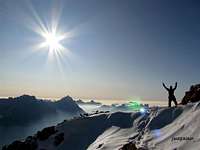-
 15146 Hits
15146 Hits
-
 85.36% Score
85.36% Score
-
 20 Votes
20 Votes
|
|
Mountain/Rock |
|---|---|
|
|
46.55685°N / 12.06389°E |
|
|
Hiking, Mountaineering, Trad Climbing, Big Wall, Scrambling, Via Ferrata |
|
|
Summer, Fall |
|
|
10623 ft / 3238 m |
|
|
Overview
The Tofane group is one of the most distinguishing in Dolomites. It has three main peaks which are of quite similar altitude: Tofana di Mezzo, 3244 m, Tofana di Dentro, 3238 m and Tofana di Rozes, 3225 m. All the three highest peaks were first conquered by Paul Grohmann along with local mountain guides, in 1863 (di Mezzo), 1864 (di Rozes) and 1865 (di Dentro).
The whole massif lies west of Cortina d'Ampezzo, so according to the classification we use here on SP, it belongs to Cortina Dolomites. On the south, the border of the Tofane group is the valley which runs from Cortina d'Ampezzo to the Falzarego Pass (2105 m). On the east, the massif ends deep down in the Ampezzo valley. While on the western side, the massif is divided from the Lavarella group by the valley of Travenanzes.
Geologically the massif of Tofane is made of "dolomia principale", a typical dolomite rock.
The Tofane massif offers a variety of outdoor activities. On the eastern part, above the Cortina d'Ampezzo, there is a well-known ski resort, where every year also the World Cup races are held. And on the very peak of Tofana di Mezzo a cable car goes. Otherwise, in the whole massif, there are many hiking and climbing routes and in the vertical walls of the massif the hardest climbing routes can be made. Especially the south face of Tofana di Rozes is monumental, offering the hardest climbing routes.
All three main peaks can be ascended by marked routes, but they are far from being easy.
Summit views
Getting There
From Cortina d'Ampezzo drive towards the west in the direction of the start points of lifts to Tofana di Mezzo. Before you take a right turn toward Riffugio Col Drusie, you will see Ristorante Pietofana. That is a place where you will park your car. 30-40 meters from the restaurant there is a sign with number 407 for pine forest until you come out on the steep scree slopes used as pisat. Climb up all the Forc. Ra Vales. That is the number of a trail you will follow for a normal ascent to Tofana di Dentro.
Description of the climb:
From the fork go left along the track that describes a wide arc and recovery of rocky terraces up to get into the gravel coming down from the Tofane. Cross the gravel slightly uphill to the ruins of some barracks during the war and it goes back to a fork, through a hole in the rock. It falls short on the other side and follows the track that held back many of the terraces and gravel cengette taking the fork that separates the Tofana Formenton by Cima. Going up the left path up a little 'plane equipped with short and gravel is the bivouac of the Alpine Hut, a small nest of eagles nestled between the rocks and the perfect place for overnight. Continue up the ridge N to follow along the wire and then to the gravel track between the side of the little man up to Cortina summit.
Descent:
As for raising or traversing the Middle Tofana via Ferrata easy but exposed in some places, then a cable car to Rifugio Ra Vales and then footpath 407 to the point of departure.
Notes:
Long climb that requires a good workout even on the share, very scenic and lonely, to be avoided in bad weather or snow. Via Ferrata equipment to make the trip to the Middle Tofana.
For those who do not strive only for high peaks also a round tour can be made, which encircles the whole Tofana massif by a marked path.
Maps:
1. Tabacco 1:25000, No. 3 - Cortina d'Ampezzo
Red Tape
The whole massif (except the ski resort) is part of the Dolomites Natural Park.
When to Climb
Summer and autumn months are the most appropriate. In early summer you should count on many snow rests on the northern side of the mountain, so take with you the appropriate equipment. In autumn months (October and especially November) you can expect some snow, icy rocks and very cold evenings.
Camping
In the Dolomites Natural Park, camping is not allowed.
1. The best option for ascending Tofana di Dentro is to overnight in Baracca degli Alpini (2.922m) which is just below the summit. That way you can enjoy the beautiful sunset and sunrise above the valley of Cortina before reaching the summit. The bivouac itself is, like many other objects in this area, the original structure of the First World War. It has space for 7-8 persons. Inside there is even a small functional stove, but as a visitor, you could face the problem of lack of firewood.
At the time I was there (first half of October), it was completely empty.
It is open all year round.
More tourist information can be found on the page of Cortina d'Ampezzo.








